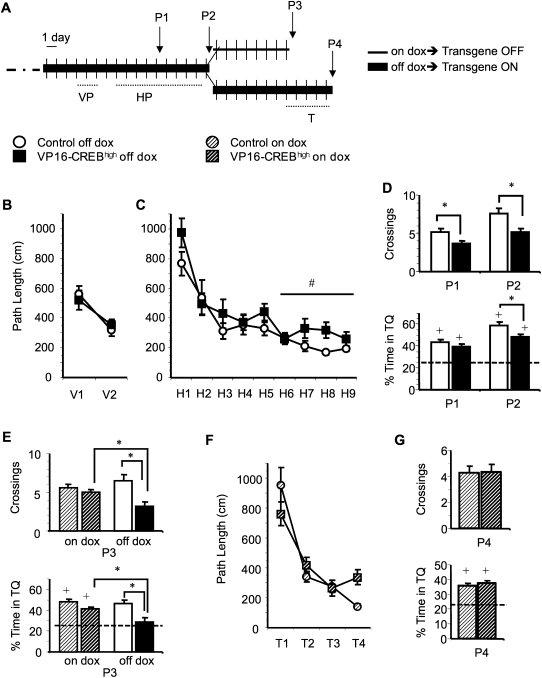Figure 1.
VP16-CREBhigh mice show impaired spatial memory in the water maze. (A) Schematic summary of the experimental protocol. VP16-CREBhigh (n = 35) and control mice (n = 21) were trained in the visible platform (VP) and hidden platform (HP) tasks using a four-trial per day protocol. Dox was removed from the mouse diet 3 d before starting the VP task (8 d before training in the HP task). Probe trials to assess memory acquisition were performed before training on day H5 (P1) and 24 h after concluding training in the hidden platform task (P2). After P2 (day 10 of the HP task), a randomly selected subgroup of VP16-CREBhigh mice (18) and control littermates (15) were fed again with dox food to turn off transgene expression and assess the reversal of memory deficits. The remaining 23 mice (17 VP16-CREBhigh mice and six control siblings) were kept off dox. One week later, we performed an additional probe trial (P3) and started to train the same mice using a new platform location. (T) Transfer task. A last probe trial (P4) was performed 24 h after training on T4. (B) Mice from both genotypes showed similar acquisition curves during training in the visible platform task. (C) Both genotypes also showed similar learning during the first week of training in the hidden platform task. However, VP16-CREBhigh mice failed to improve their performance as much as control littermates during the second week of training. (D) Spatial memory for the HP task was assessed in two probe trials (P1 and P2). Mice expressing constitutively active CREB spent less time in the TQ in P2 than control siblings. The analysis of annulus crossings revealed significant deficits both in P1 and in P2 (top), whereas the analysis of percentage of time in TQ only revealed significant changes in P2 (bottom). (E) The memory defect of bitransgenic mice was readily reversed by turning off transgene expression before performing a third probe trial (P3). This reversal was observed both in the number of annulus crossings (top) and percentage of time in the TQ (bottom). (Left) Mice on dox (transgene turned off); (right) mice off dox (transgene turned on). (F) Bitransgenic mice fed with dox after the second probe trial performed similarly to control littermates in the transfer task. (G) Bitransgenic animals did not show significant defects in annulus crossings (top) and time spent in the TQ (bottom) in the fourth probe trial. (#) Significant difference between genotypes in sessions H5–H9 (P < 0.05, repeated measures ANOVA); (*) significant differences between groups (P < 0.05, t-test); (+) significantly different of the chance value 25% (P < 0.05, t-test).

